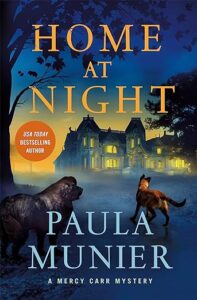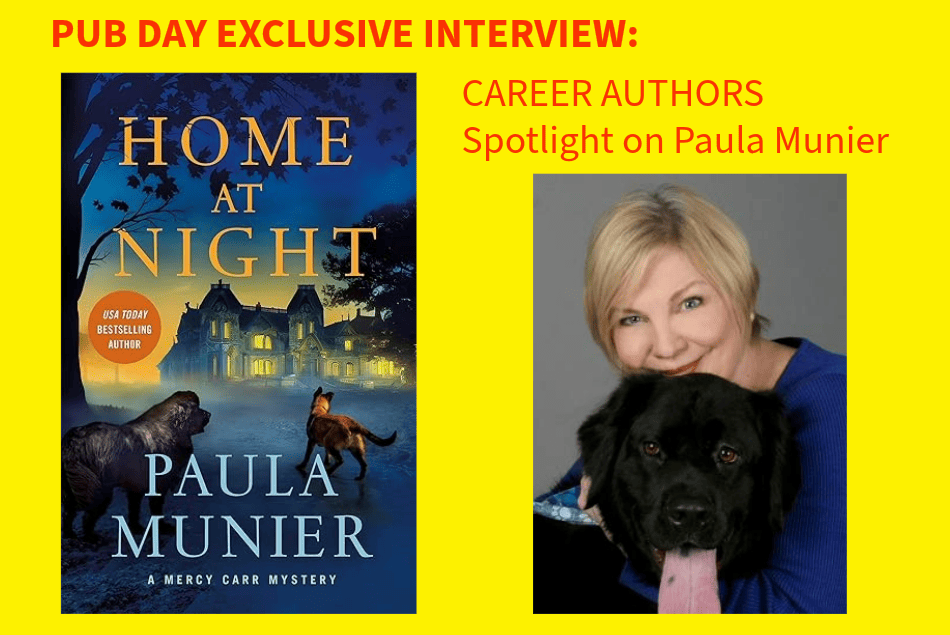Mark Twain said, “The more I learn about people, the more I like my dog,” and that sort of thinking may explain why some of us seek out and love reading novels featuring animal characters. I also like characters who love dogs. In other words, I love Paula Munier’s Mercy Carr mysteries, and Home at Night, the newest book in that critically acclaimed series which was just published yesterday. (Order here.)
Paula’s novels include wonderful human characters too. Home at Night features two dogs, a cat, and approximately five humans. I especially adore her grandmother Patience. But today I want to talk about dogs and cats. Paula and her books have won many awards, but in 2019 A Borrowing of Bones was named the Dog Writers Association of America’s Dogwise Book of the Year—which makes me want to learn her secrets to writing critically-acclaimed novels featuring animal characters.
Dana: I spend all day every day anthropomorphizing my dog. I’m also sure she understands me better than I understand her. So how do you actively avoid giving canine characters human characteristics?
Paula: I don’t actively avoid giving canine characters human characteristics so much as I simply write the dogs the way they are. Each dog has such a specific personality, every dog is such an individual. We have four dogs right now, and they each couldn’t be more different one from the other. I pay attention to what they do and then I write it down. And of course, I do a lot of research on all the different breeds. I talk to all kinds of dog handlers, police officers with drug-sniffing dogs and firefighters with arson-detecting dogs and soldiers with bomb-sniffing dogs. If you have dogs, you know how attentive they are to you. I just try to be attentive in return.
Dana: Are there dog-reader dog-expectations or standards to be maintained? In other words, have you been anthropomorphically busted?
Paula: I have never been anthropomorphically busted but I have been called out for giving the canine characters in the Mercy Carr series “people food.” I’ve gotten more than one email from readers who are unhappy with the dogs’ diet. Now I make it very clear that they get good vet-approved kibble most of the time and that treats are rare—and that they’re vet-approved as well.
Dana: We read of humans taming wolves to become their forever faithful companions, but it might be the other way around: dogs have civilized us. I know my dog makes me a better person, or at least I have to be nice to my neighbors. Do you find that animal characters help further the emotional development of your plots?
 Paula: My series heroine Mercy Carr is a military police officer serving in Afghanistan who’s wounded in the same battle in which her fiancé is killed. He asks her to take care of his bomb-sniffing dog—and together they go home to Vermont, both grieving, both missing their man and their mission. Over the course of the series, they help each other through the grieving process and their transition to civilian life. In every book, Elvis teaches Mercy something about herself and about others and about the world at large. Dogs are great teachers if we only stop to listen and learn. Of course, that’s true of all nature and all wildlife. There are lessons to be learned if we just pay attention.
Paula: My series heroine Mercy Carr is a military police officer serving in Afghanistan who’s wounded in the same battle in which her fiancé is killed. He asks her to take care of his bomb-sniffing dog—and together they go home to Vermont, both grieving, both missing their man and their mission. Over the course of the series, they help each other through the grieving process and their transition to civilian life. In every book, Elvis teaches Mercy something about herself and about others and about the world at large. Dogs are great teachers if we only stop to listen and learn. Of course, that’s true of all nature and all wildlife. There are lessons to be learned if we just pay attention.
Dana: Certainly different readers have different expectations. I like a realistic dog portrayal but I also enjoy Rita Mae Brown’s talking dogs and cats observing what dopes humans are.
Paula: I love Rita Mae Brown’s talking dogs and cats, too, but my go-to doggie POV is Spencer Quinn’s Chet, the dog who flunked out of cop dog school and finds himself in the company of hapless PI Bernie solving crimes out West. Chet gives us his unique perspective on all of the two- and four-legged creatures he encounters; this is quite a trick for any writer to pull off successfully—and it’s a tour de force every time. I’m thrilled to say that I’m doing a live event with Peter, AKA Spencer Quinn, at The Poisoned Pen on October 24. If you’re anywhere near Scottsdale, you should come and see us. I’m just saying.
Dana: How much fictional fodder does your own pack of dogs provide?
Paula: I think that my own pack of dogs (and Ursula the Cat!) gives me lots of fuel for the fire in my books. Dogs have been bred to pay such close attention to humans that they often know what we’re going to do before we do. They anticipate our reactions and they’re ready every single time. That’s what I love about them, and why it’s so fun to write about them. That said, adding dog characters to your scenes means keeping track not only of where the human characters are and what they’re doing, but where the dogs are and what they’re doing as well. Sometimes it gets a bit crowded!
For me, having dogs who are the same breeds as the dogs in the book is a great gift. In the books, Elvis is a Malinois, very different from Susie Bear, the Newfoundland. At home we have Blondie the Malinator and Cocoa Puff the Newfie—and I see that difference up close and personal. Blondie is a sleek, smart, wildly athletic dog. Cocoa Puff is a five-month-old, 56-pound Slinky of a dog whose body parts never move in concert with one another. She tries to do what Blondie tries to do; Blondie leaps and she’s this elegant, fierce ballerina flying through the air, and then Cocoa Puff tries to do the same thing and just falls flat on her face. It’s a real compare-and-contrast right here at home, which helps me get the dogs right in the books.
Dana: Animals in books must be more than decorative; readers want them to be characters. When considering featuring animals in your books, did you admire their portrayals by any other writers? What authors write animals well?
Paula: There are many writers who write well about animals. In crime fiction, you have the New York Times bestselling author and king of golden retrievers, David Rosenfelt, who writes the hilariously entertaining Andy Carpenter series; the fabulous Margaret Mizushima, author of the Timber Creek K-9 police procedurals set in the Colorado Rockies; and of course Rita Mae Brown and her beloved Sneaky Pie. All feature animal characters who will steal your heart, but none more than Spencer Quinn’s aforementioned Chet and Bernie mysteries, guaranteed to make you laugh and cry and think. Once when I was feeling rather blue, I read five of these books over the course of three days. And I must say that I felt much better.
There are many novels featuring animal characters that I also recommend: Remarkably Bright Creatures by Shelby Van Pelt, which opens with a scene written from the point of view of an octopus. Brilliant! Then there’s Oprah pick The Story of Edgar Sawtelle by David Wroblewski, a Hamlet retelling with dogs; Separation Anxiety by Laura Zigman, in which a woman carries her dog around her middle in a sling like an infant to soothe the dog (not!); and the heart-wrenching Lily and the Octopus by Steven Rowley. I won’t even mention The Art of Racing in the Rain by Garth Stein, which I cry just thinking about. Or Mary Oliver’s Dog Songs.
I could go on and on but let me end with my favorite dog book of all time. It’s a dog memoir (a sub-genre I love so much I wrote one myself: Fixing Freddie: A True Story about a Boy, a Mom, and a Very, Very Bad Beagle). At only 208 pages, Abigail Thomas’ A Three Dog Life is a beautifully written little volume that packs a big punch—and my favorite memoir of any kind. Read it and then we’ll talk.
Dana: Do you like dogs more than people?
Paula: No comment.





